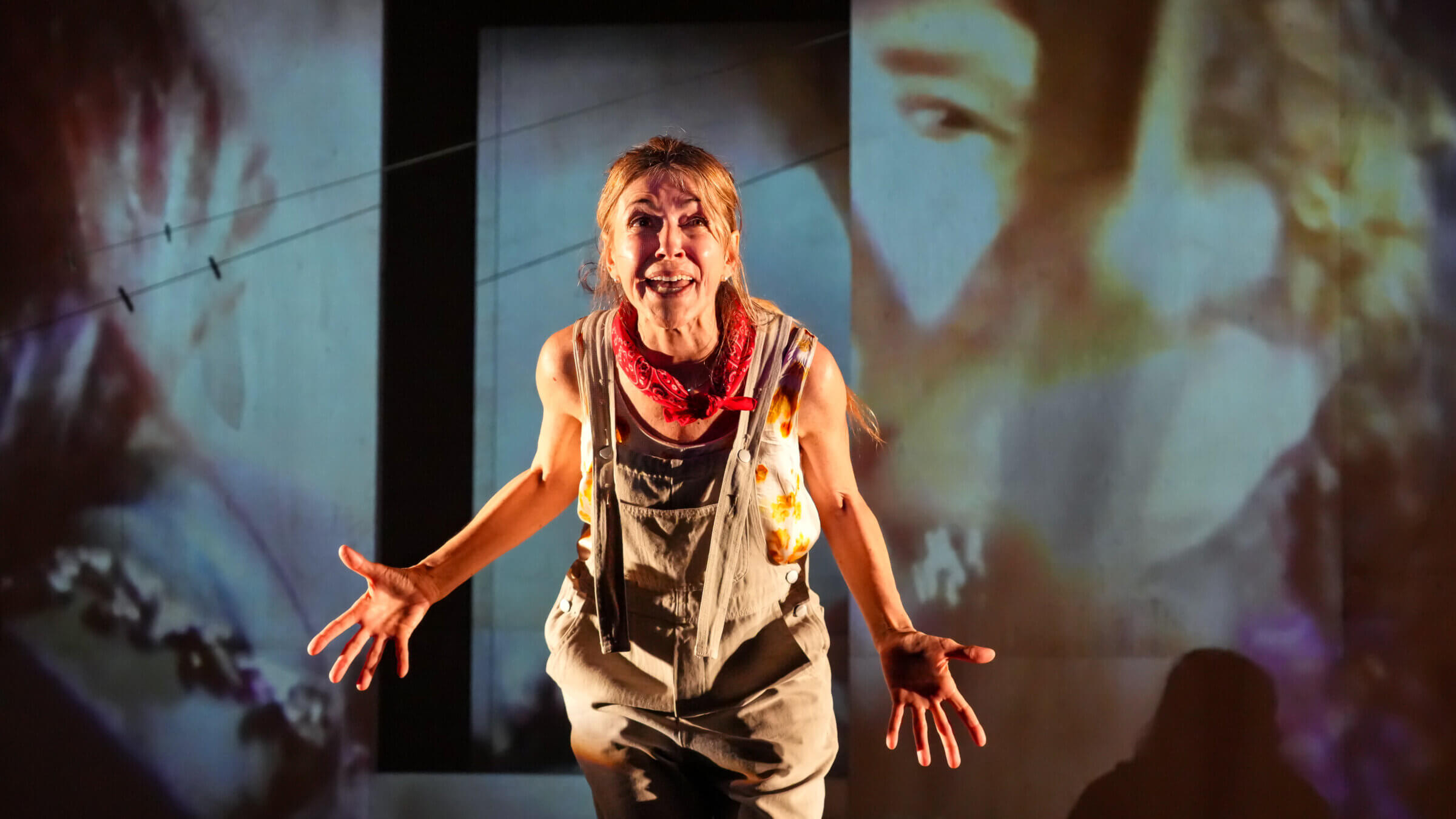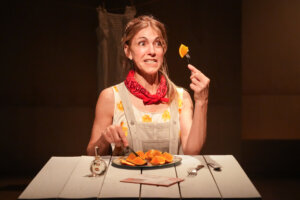In the face of authoritarianism, a subversive play forces us to confront our own complicity
Argentinean artist-activist Claudia Bernardi is the subject of Catherine Filloux’s ‘How To Eat an Orange’

Paula Pizzi stars in Catherine Filloux’s How to Eat an Orange. Photo by Steven Pisano
There’s a particularly indelible moment toward the end of How to Eat an Orange, Catherine Filloux’s world-premiere play about the prolific Argentinean artist-activist Claudia Bernardi. Moments before displaying a vibrant mural that was created in response to a 1981 massacre in El Salvador, Claudia (Paula Pizzi) recalls, wrenchingly, exhuming the bones of the young victims. They were so frail, she says, that she feared that “The trace of existence / would evaporate forever / and with it the presence / of this child.”
Such invisibility is what Filloux, and her subject, seek to combat and condemn in Elena Araoz’s spare production at La MaMa. The collage-like solo show demands that its audience interrogate what we expect “tragedy” to look like, and what we crave, or demand, from art that depicts or responds to it. Orange seems to argue that — particularly in addressing crimes against humanity — the dignity of the victims depicted should take precedence over the audience’s need to use and exploit their tragedies to indulge in their own personal catharsis.

This argument — made implicitly, through style and structure — feels timely, amid debates surrounding “trauma porn” and the boundary between commodifying suffering and censoring it. Filloux’s own family history — she was raised on the border between San Diego and Tijuana, the daughter of an Algerian mother and a French father who grew up during the Nazi occupation — gravitates toward stories of tyranny and atrocity. She has traveled the globe to research her plays, which have wrestled with human rights violations in such places as Cambodia, Turkey and the United States. Women — their unique resilience and vulnerability alike — are a throughline in her work.
Filloux has described her work as “constantly mov[ing] from the micro to the macro,” and there’s a welcome — though, indeed, occasionally disjointing — abruptness on display in this latest piece. As Claudia recalls coming of age during the 1976-1983 military junta (the “Dirty War”) and her subsequent work with the Argentine Forensic Anthropology Team, after each moment in which we are horrified by the scale of the brutality she describes, we are immediately snapped back into a seemingly innocuous, wistful moment of nostalgia, and vice versa.
At one moment, Claudia recounts the screams that reverberated through the jail where she was detained after reporting a stolen wallet to the police; in the next, she reminisces about eating begonias with her sister when they were children. But even as Claudia divulges some of her most acutely horrific memories, she asserts that, “There are things in this blister that I will never speak.” It is on us, the audience, to synthesize the play’s fragmentary nature (beautifully enhanced by the marriage of Daniel Landez’s set and Milton Cordero’s projections).
The play’s very title reflects Filloux’s desire to dissect that which may seem commonplace in a life defined both by extraordinary trauma and violence, as well as beauty and resilience. It is bookended by Claudia explaining — and demonstrating — her idiosyncratic approach to doing the titular activity (a multi-step process requiring a fork and knife). “I think I learned how to eat an orange / from my mother. / I have done it all my life,” she concludes.
There is a fluidity, lyricism, and delicacy to the production, with understated direction by Araoz, that distinguishes it from what may be a more familiar style of solo performance — one that’s somewhat frenetic and highly theatricalized. Perhaps that’s due to the fragility of the content, or Bernardi’s own real-life soft-spoken demeanor. In this way, Claudia feels more like a conduit, and, sometimes, the play’s constellation of anecdotes don’t create the sense of intimacy audiences might crave.

At times, I felt the play holding me in its clutches — insisting I take inventory of my own complicity — then letting go prematurely, granting me an ease or release that perhaps I hadn’t earned. Furthermore, when Pizzi embodies other characters (albeit briefly) — such as Clyde Snow, the Texan forensic anthropologist who oversaw the exhumations, alongside undergraduates, like Claudia’s younger sister, Patri — she seems to approximate, rather than fully inhabit, them. Nonetheless, when I felt myself aching for further depth and detail, I wondered if what I felt I wanted was truly necessary, and what my desire for or expectation of it said about me.
The slow burn of How to Eat an Orange demands the viewer’s patience, but the piece also refuses to be taken in isolation. As our culture of instant gratification increasingly infiltrates the performance ecosystem, I appreciate a play that lingers with me, its resonance deepening as I think about it. The most trenchant moments in Filloux’s play serve as a reminder of the basic human instinct toward creation as a response to the ineffable and unconscionable. And that, to remain hopeful yet rigorous in the vitality of art is itself a resistance against authoritarianism, which, across time and space, has relied upon the silence of artists.
















